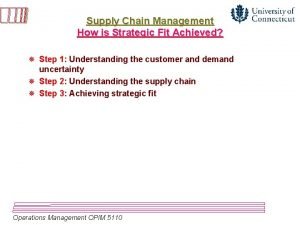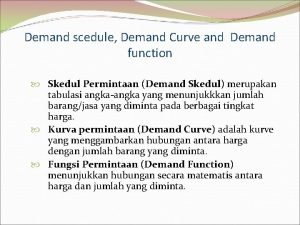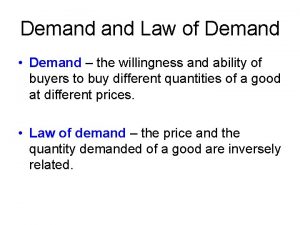Supported Living Needs and Demand Spend analysis AWD



















- Slides: 19

Supported Living – Needs and Demand

Spend analysis – AWD Supported Living Services – Key Information 1152 Adults With Disabilities making use of Supported Living placements managed by ECC (1106 LD, 46 PSI) Average Weekly spend on a Supported Living Package is £ 1167, total spend per week is £ 1, 344, 924, full year effect is £ 70, 124, 337 Average spend across 1106 LD packages is £ 1178 pw, average across 46 PSI packages is £ 851 pw Placements are made in 403 different Supported Living properties, operated by 89 providers

Packages by Age Group 18 -25, 76 -80 and 86 -90 age groups have the most expensive average packages. The number of packages in the older categories is small. The higher average cost of the young age group is particularly noteworthy, other than this there is no clear relationship between age and average package size.

Packages by Age Group - AWD Data shows a high number of individuals in age categories 18 -25, and 51 -55 and 56 -60. The high number of young individuals is again noteworthy. The high number of older users in the 51 -60 categories could indicate a “second intake” at this age band – people who had other accommodation arrangements until this point in time, and could also be linked to historic hospital re-provision

Placements by Budget Quadrant – LD only This shows the number of LD placements by the originating quadrant; North clearly showing the highest number This shows the weekly LD spend by quadrant; of note is that Mid’s proportion of the spend is smaller than their proportion of placements made. In both cases, “other” is mostly made up of transitions placements

Placements by Budget Quadrant - LD This shows the weekly spend on LD placements by quadrant, confirming that the average weekly package size for placements made by the Mid quadrant is lower. “Other” mostly represents younger people, confirming that the cost of packages for younger people is higher than other age groups.

Out of County Placements - Totals Local Authority Number of Service Users Sum of Spend Per Week Total Per Year Birmingham City Council 1 £ 827. 95 £ 43, 171. 71 East Sussex County Council 1 £ 2, 063. 66 £ 107, 605. 22 Hertfordshire County Council 9 £ 10, 348. 44 £ 539, 597. 67 Isle of Wight Council 1 £ 2, 338. 56 £ 121, 939. 30 Kent County Council 1 £ 1, 128. 78 £ 58, 857. 86 Leicestershire County Council 1 £ 264. 24 £ 13, 778. 24 Lincolnshire County Council 1 £ 440. 75 £ 22, 981. 98 London Borough of Barking and Dagenham 1 £ 1, 116. 26 £ 58, 205. 03 London Borough of Barnet 1 £ 807. 40 £ 42, 100. 18 London Borough of Croydon 1 £ 1, 716. 02 £ 89, 478. 26 London Borough of Newham 2 £ 2, 212. 14 £ 115, 347. 39 London Borough of Redbridge 3 £ 3, 406. 06 £ 177, 601. 85 London Borough of Sutton 1 £ 2, 466. 24 £ 128, 596. 91 Milton Keynes Council 1 £ 102. 76 £ 5, 358. 20 South Gloucestershire Council 1 £ 1, 122. 60 £ 58, 535. 62 Southend-on-Sea 35 £ 42, 972. 40 £ 2, 240, 705. 56 Suffolk County Council 5 £ 4, 878. 16 £ 254, 361. 41 Thurrock Council 4 £ 1, 159. 72 £ 60, 471. 16 Grand Total 70 £ 79, 372. 14 £ 4, 138, 693. 56 This shows the number of out of county placements by host authority, with the sum of spend in that area per week and per year. The number of placements is obviously higher in nearby areas, with 35 placements in Southend.

Out of County Placements – Average person Local Authority Number of Service Users Average person pw Average Per Year Birmingham City Council 1 £ 827. 95 £ 43, 171. 71 East Sussex County Council 1 £ 2, 063. 66 £ 107, 605. 22 Hertfordshire County Council 9 £ 1, 149. 83 £ 59, 955. 30 Isle of Wight Council 1 £ 2, 338. 56 £ 121, 939. 30 Kent County Council 1 £ 1, 128. 78 £ 58, 857. 86 Leicestershire County Council 1 £ 264. 24 £ 13, 778. 24 Lincolnshire County Council 1 £ 440. 75 £ 22, 981. 98 London Borough of Barking and Dagenham 1 £ 1, 116. 26 £ 58, 205. 03 London Borough of Barnet 1 £ 807. 40 £ 42, 100. 18 London Borough of Croydon 1 £ 1, 716. 02 £ 89, 478. 26 London Borough of Newham 2 £ 1, 106. 07 £ 57, 673. 70 London Borough of Redbridge 3 £ 1, 135. 35 £ 59, 200. 62 London Borough of Sutton 1 £ 2, 466. 24 £ 128, 596. 91 Milton Keynes Council 1 £ 102. 76 £ 5, 358. 20 South Gloucestershire Council 1 £ 1, 122. 60 £ 58, 535. 62 Southend-on-Sea 35 £ 1, 227. 78 £ 64, 020. 16 Suffolk County Council 5 £ 975. 63 £ 50, 872. 28 Thurrock Council 4 £ 289. 93 £ 15, 117. 79 Overall Average 70 £ 1, 126. 66 £ 58, 747. 13 This shows the average cost per week and per year for each of the areas hosting out of county supported living placements. The average out of county placement costs £ 1126 per week, slightly cheaper than the overall average (£ 1167 per week) although the pattern varies by location. Southend hosts half the out of county placements with an average of £ 1227, above the county average.

Demand Analysis - Overview • Demand for supported living is difficult to forecast using current social care systems. Need is assessed as individuals move through transitions to adult services, and then at the point of review with individuals as their needs change over time. Because reviews are an individual, person-centred process it is currently difficult to aggregate any data that can reliably determine future needs for supported living schemes. • In order to come to a figure for demand a number of different sources of information have been utilised: – The Specialist Accommodation Leads (SALs) waiting lists, currently drawn from their work with operational teams and the Living Options Forums. – The number of new placements made over recent years (limited by the fact that domiciliary care and supported living were grouped together until recently) – Information on the current placements within residential schools and colleges from transitions teams • This data gives a high level picture of the number of placements that may be required within supported living services in the coming years, but only provides an estimated number and doesn’t give the context required around the needs of the people being placed. The SALs waiting lists are a snapshot in time, based on current provision, but do give some indication of the relationship between need and provision in different localities. •

Demand Analysis - Transitions and Residential Schools • Essex currently have placements at 54 different residential schools. The majority of these schools are out of county. • There are 108 individual placements within these residential schools with ages ranging between 5 and 20 years old. • 96 of these people are aged above 13 years old and could come through adult services in the next 5 year period. • Planning for these people needs to commence as soon as possible to ensure that the market is geared up for their needs and there is sufficient provision at reasonable rates in order to avoid expensive placements out of county or into residential care. 10

Demand Analysis - Transitions • • • This shows the breakdown of age of those people currently receiving services within residential school settings, and a potential pipeline of people that may require supported living services in the next 5 years. The data does not show the complexity of each individual however and it could be expected that a proportion of people may be housed through shared lives or residential care. This group of people will need to be analysed to understand the expected pathway for them into adult services to allow pro-active planning for services and providers in the market. 11

Demand Analysis - Waiting Lists The Specialist Accommodation Leads (SALs) work with operational teams to maintain a list of individuals who are currently seeking accommodation options. Within each waiting list there a number of individuals who will not be suitable for any of the current options, whilst the rest will be in the process of exploring suitable properties. Locality No. on waiting List Of Which have no current options North 47 9 South 29 14 West 24 7 Mid 25 9 The waiting list can be broken down by user groups as follows: Locality LD/Autism Complex PI North 40 4 3 South 22 6 1 West 22 1 1 Mid 20 4 1

Demand Analysis - Waiting Lists The concentration of services and service users varies across localities, and the turnover of service users and vacant placements can vary according to a wide variety of factors. The SALs maintain information on how long individuals have been on the waiting list over the last 12 months, which can indicate gaps in local provision Locality Average Time on Waiting List North 34 weeks South 34 weeks West 62 weeks Mid 64 weeks According to the SALs, three factors can lead to individuals spending longer on the waiting list: - Having a primary need related to Physical Impairment - Having complex needs related to LD and autism - Individuals and/or families expressing very particular needs around the property or the area they wish to live in. Waiting list numbers are reported as fairly consistent, although the list is not maintained in a way that allows for analysis of historic records.

Demand Analysis - Waiting Lists The SALs also maintain information about the vacant tenancies (voids) within each locality. There are several factors that feed into the number of voids: • a room may not have been onboarded yet; • the scheme may provide specialist services which take longer to place; • the scheme may not be ideally placed; • the building may not be appealing; • there may be issues with compatibility with current residents • there may be oversupply of that type of accommodation in an area • there may just be more service users in that area, so more turnover • there could be a number of new schemes recently onboarded but not filled Locality Number of vacant tenancies North 60 South 14 West 17 Mid 22 Out of County 4 (in schemes that are used by Essex) The number of vacant tenancies should feed into future coordination of scheme development.

1 Demand Analysis – Executive Summary 5 Most placements are made in county but on average current out of county placements cost ECC £ 41 per week less per placement There are 96 people aged 13 and above in residential schools which will provide a pipeline for new supported living placements Supported Living waiting lists vary from 47 in the North down to 24 in the West; average time on the waiting list varies from 64 weeks in Mid to 34 weeks in South There are vacant placements across the county, with 14 in South and 60 in North

Business Requirements – LD and Autism The population of people with learning disabilities is relatively stable, but does account for a significant proportion of adult social care expenditure. Demand is variable by age group. In the period to 2030, it is forecast that: There are estimated to be 27, 000 people who have a learning disability and/or autism living in Essex and approximately 4, 100 people receive a service which is funded by Essex County Council. By 2035 it is forecast that the amount of people living in Essex with a Learning Disability and/or Autism will increase by 14. 4% Though the number of 18 -24 year olds is expected to fall in the mid-term (in line with overall population projections), 18 -24 numbers are expected to increase over the longer term (by 2030). Fluctuations in LD population for certain age groups, therefore, are not expected to translate to an overall lower demand for LD support Improved life expectancy is also expected to contribute to population growth in higher age bands and the raise potential for additional complexity. Currently 13% of LD service users have low to medium needs and receive 0 -14 hours of care a week. 47% of service users have high and intensive needs – receiving over 57 hours a week care. 21% have very low needs and 20% have medium needs (receiving 15 -56 hours a week). In 2015/16, adults with LD in secure employment stood at 9%, which was higher than the national average of 6. 6% but still low. Of the 937 young adults entering adult social care in the last 5 years, 692 (74%) had a Special Educational Need. Around 270 (28% of the total) had a Severe Learning Difficulty or profound multiple learning disabilities; 173 (18%) were on the autistic spectrum

1 Business Needs 7 From engagement with operational and commissioning colleagues a clearer picture of ECC’s requirements from the supported living market is formed, consisting of: Complex and specialist services for adults with high and complex needs around LD and Autism Transitional services for young people who may require a period of enablement to prepare them for living in their own home Support in an environment where the individual has secure tenants rights, and can work towards achieving outcomes over time Flexibility of approach to allow for an efficient way of meeting individuals’ changing needs Specialist complex physical and sensory services to allow for needs that are currently being met through other means, or out of county There has been a recent increase in the number of relatively urgent supported living placements for complex LD and Autism; the flexible and bespoke nature of the support is seen as ideal for meeting the needs of this group. There is also acknowledgement that there is a degree of hidden need for complex physical or sensory support with social workers aware that supported living options are currently limited and making use of alternatives as a result.

Market Analysis – AWD Supported Living ECC records show 89 providers delivering Supported Living services within Essex across 403 addresses There are 19 providers with whom ECC spend over £ 1 m. The average spend per provider is £ 787, 914 The provider market is diverse with several larger national providers mixed with many smaller organisations Providers’ offers are diverse, with individual providers operating a range of very different schemes depending on the needs of residents

1 Market Analysis – AWD Supported Living 9 This data shows the number of supported living schemes currently operating in Essex, drawn from data held by the Specialist Accommodation Leads (SALs). The schemes are not broken down by level of need because this is so flexible and can vary over time even within a scheme. Social workers currently rely on local intelligence to determine which schemes can provide complex services. The SALs are currently undertaking a programme of onboarding any rooms that are vacant even within existing properties, to ensure that they meet minimum ECC standards. The total number of placements therefore includes some rooms that have not been onboarded yet (some of which are currently occupied, some of which are vacant. ) District Supported Living Sites Total number of placements Average number of rooms per scheme Basildon 45 129 2. 87 Braintree 49 123 2. 51 Brentwood 20 79 3. 95 Castle Point 10 44 4. 40 Chelmsford 29 149 5. 14 Colchester 101 276 2. 73 Epping 21 57 2. 71 Harlow 12 49 4. 08 Maldon 1 2 2. 00 Rochford 7 25 3. 57 Tendring 55 200 3. 64 Uttlesford 15 49 3. 27 387 1236 3. 19 Grand Total • This reinforces what we know about the uneven distribution of schemes across the county • Whilst Maldon only has a small number of schemes for a small population, it is interesting to note that Rochford district has a small number of schemes for a relatively densely populated area. This is likely to be masked by the high amount of out of county placements made into Southend. • Schemes vary in size, with a lot of 2 bed properties and a small number of larger sites. The average size of a scheme across the county is just over 3 rooms. • Chelmsford, Castle Point and Harlow have the largest average scheme size
 Past simple past continuous present perfect
Past simple past continuous present perfect Primary needs and secondary needs
Primary needs and secondary needs Satisfaction
Satisfaction Primary needs and secondary needs
Primary needs and secondary needs Strategic gender needs and practical gender needs
Strategic gender needs and practical gender needs Target needs in esp
Target needs in esp Module 5 supply and demand introduction and demand
Module 5 supply and demand introduction and demand Pyramid hesd
Pyramid hesd What are the 5 basic needs of all living things
What are the 5 basic needs of all living things Fiscal measures to correct deficient demand
Fiscal measures to correct deficient demand Independent demand vs dependent demand
Independent demand vs dependent demand Kagustuhan+kakayahan=demand
Kagustuhan+kakayahan=demand Demand forecasting and estimation
Demand forecasting and estimation Paradox of value
Paradox of value Independent demand inventory management
Independent demand inventory management Attwirless
Attwirless Efs supplier portal
Efs supplier portal B0chun
B0chun How to achieve strategic fit in supply chain
How to achieve strategic fit in supply chain Is moss living or non-living
Is moss living or non-living





































